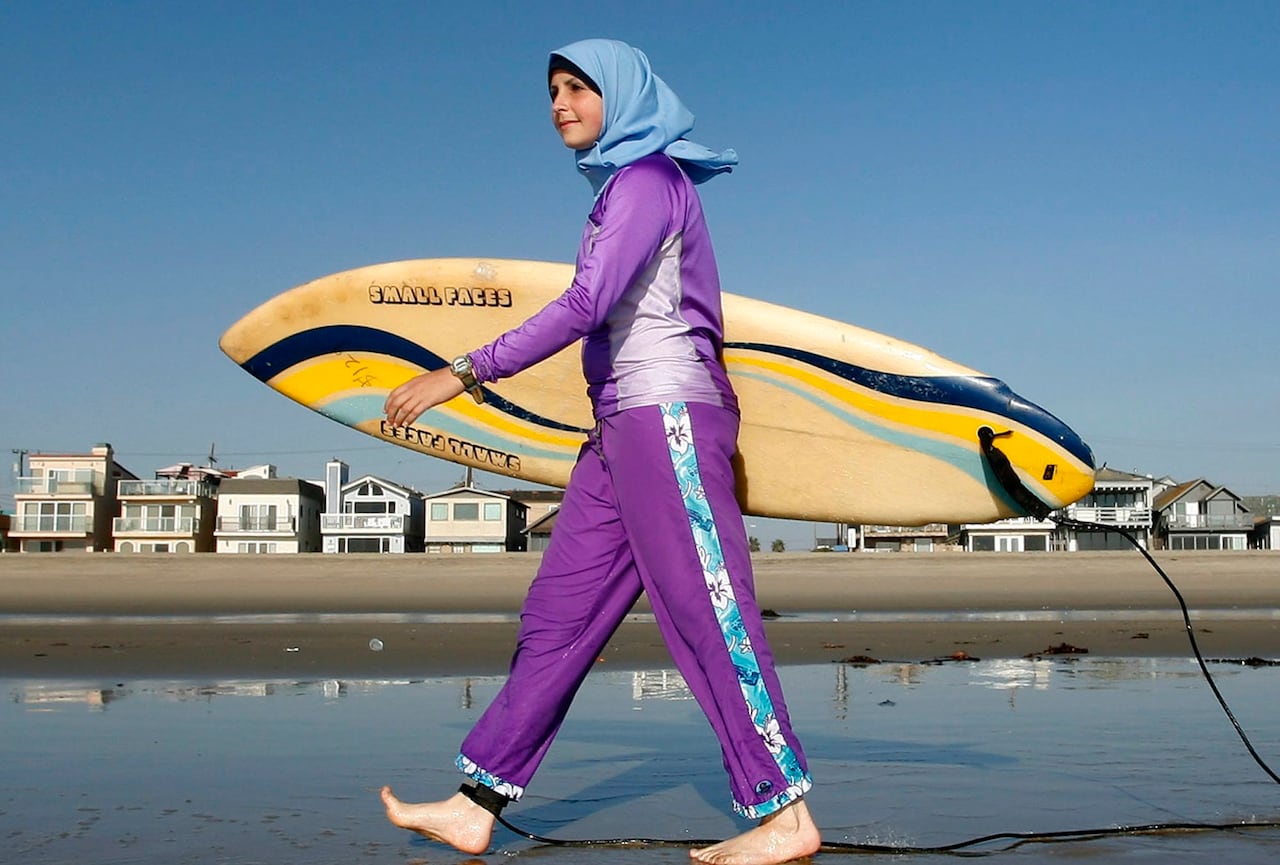Home>Women's Underwear>Swimwear>What Caused The Burkini Ban


Swimwear
What Caused The Burkini Ban
Published: July 31, 2023
Discover the reasons behind the controversial Burkini Ban. Explore the cultural and legal factors influencing the prohibition of this swimwear.
(Many of the links in this article redirect to a specific reviewed product. Your purchase of these products through affiliate links helps to generate commission for Under-tec.com, at no extra cost. Learn more)
Table of Contents
Introduction
The Burkini, a modest full-body swimsuit worn by some Muslim women, has sparked intense debates and controversies around the world. The garment, which covers the body except for the face, hands, and feet, has become a symbol of religious and cultural expression. However, it has also faced vehement opposition and even legal bans in certain countries. In this article, we will explore the historical context, arguments for and against the Burkini ban, as well as its impact on society.
The origins of the Burkini can be traced back to Australia in 2004, where Aheda Zanetti created the garment to provide Muslim women with a comfortable and practical swimwear option that aligned with their religious beliefs. It quickly gained popularity and spread to other countries with significant Muslim populations. However, the Burkini has faced widespread criticism, with some arguing that it is a tool of oppression and a challenge to Western values of freedom and equality.
The controversy surrounding the Burkini ban can be attributed to conflicting views on the balance between religious freedom, secularism, and public safety. Proponents of the ban argue that the Burkini represents a form of religious extremism and violates secular principles in societies where religion is meant to be a private matter. They claim that the ban is necessary to preserve social cohesion and protect public security. On the other hand, opponents argue that the ban infringes on individual liberty and perpetuates Islamophobia by singling out Muslim women and restricting their choices.
The debate has also raised questions about the objectification and sexualization of women’s bodies. Supporters of the ban argue that the Burkini covers women up, reinforcing patriarchy and gender inequality. They argue that women should be free to wear whatever they choose without resorting to traditional dress codes dictated by religion or culture. Meanwhile, opponents argue that banning the Burkini is a form of body policing and undermines women’s agency to make decisions about their own bodies.
The impact of the Burkini ban extends beyond the individuals directly affected by the restriction. It has sparked a wider conversation about multiculturalism, integration, and religious tolerance. The ban has also drawn attention to the experiences of Muslim women and has reignited discussions on how to balance cultural diversity with societal norms.
In the following sections, we will delve deeper into the arguments for and against the Burkini ban, examining the diverse perspectives on this contentious issue.
Historical context of the Burkini
The Burkini, a combination of the words “burqa” and “bikini,” is a relatively recent addition to the swimwear market. It was introduced by Aheda Zanetti in 2004 in Australia to provide Muslim women with a modest swimwear option that allows them to enjoy outdoor activities while adhering to their religious beliefs. The creation of the Burkini was a response to a growing demand for swimwear that accommodates the cultural and religious needs of Muslim women.
Before the advent of the Burkini, Muslim women who wanted to swim or enjoy beach activities faced significant challenges. They often had to compromise their modesty by wearing traditional clothing or endure uncomfortable situations by wearing clothes that were not suitable for swimming. The Burkini offered a solution by providing a lightweight, flexible, and quick-drying garment that covered the entire body, including the arms, legs, and hair, without compromising on style or comfort.
The popularity of the Burkini quickly spread beyond Australia to other countries with sizeable Muslim populations, such as France, the United Kingdom, and the United States. Its appeal extended beyond religious or cultural preferences, as many women of diverse backgrounds appreciated the practicality and versatility of the garment. It allowed women to participate in water sports, engage in outdoor activities, and enjoy the beach without fear of judgment or scrutiny.
However, the Burkini has faced significant backlash due to its association with religious and cultural identity. In 2016, the controversy surrounding the Burkini reached a peak when several French municipalities implemented bans on the garment, arguing that it violated French secularism and posed a threat to public order. This led to heated debates around the world, with critics accusing the bans of targeting and stigmatizing Muslim women.
The historical context of the Burkini cannot be separated from broader discussions on religious freedom, secularism, and cultural diversity. It reflects the ongoing tension between individual rights and societal norms, as well as the challenge of accommodating diverse cultural practices in a globalized world.
In the following sections, we will explore the debates surrounding the Burkini ban and examine the arguments both for and against its implementation.
Debates surrounding the Burkini ban
The Burkini ban has ignited passionate debates, with strong arguments presented on both sides of the issue. Advocates for the ban argue that it is necessary for reasons of secularism, public safety, and gender equality, while opponents argue that it infringes upon individual freedom, promotes discrimination, and undermines religious and cultural diversity.
Supporters of the Burkini ban argue that the garment symbolizes religious extremism and challenges secular principles. They assert that in societies where religion is meant to be a private affair, the Burkini is a visible manifestation of the encroachment of religious norms into public spaces. They contend that enforcing the ban is essential to preserving the neutrality of public domains and upholding the values of secularism.
Furthermore, proponents of the ban argue that it is necessary for reasons of public safety. They claim that the Burkini may pose a security risk, as it conceals the wearer’s identity, and makes it difficult to ascertain the intentions of individuals in crowded spaces. They argue that by implementing the ban, authorities can ensure greater control and prevent potential security threats.
The issue of gender equality also features prominently in the debates surrounding the Burkini ban. Supporters argue that the garment perpetuates patriarchal norms by covering women and reinforcing the notion that women’s bodies need to be hidden and controlled. They suggest that the ban is a necessary step in dismantling the objectification and subjugation of women, encouraging them to embrace more liberal and progressive values.
However, opponents of the Burkini ban contend that it curtails individual freedom and undermines the principles of personal choice and autonomy. They argue that decisions about personal dress should be left to the individuals themselves, free from state intervention. In their view, the ban is a form of religious and cultural discrimination, specifically targeting Muslim women and limiting their ability to express their religious identity.
Furthermore, critics argue that the Burkini ban perpetuates Islamophobia and reinforces negative stereotypes about Muslims. They argue that singling out a specific religious group creates a climate of fear and hostility, leading to further marginalization and stigmatization of Muslim communities. They emphasize the importance of fostering inclusivity and respecting cultural diversity, rather than imposing restrictions that only serve to isolate Muslim women.
The debates surrounding the Burkini ban go beyond the specific issue at hand. They touch upon broader discussions about multiculturalism, integration, and the balance between personal beliefs and societal norms. The conflicting viewpoints reflect the complex challenges societies face in navigating cultural diversity while preserving fundamental values such as freedom, secularism, and equality.
In the following sections, we will explore in more detail the arguments both for and against the Burkini ban, gaining a deeper understanding of the perspectives that underpin this contentious issue.
Arguments for the Burkini ban
Proponents of the Burkini ban present several arguments to support their position. They believe that the ban is necessary to uphold principles of secularism, maintain public safety, and promote gender equality.
One of the primary arguments for the Burkini ban is rooted in the principle of secularism. Advocates argue that in countries where there is a clear separation of religion and state, religious symbols or attire should not be displayed in public spaces. They assert that the Burkini represents a visible manifestation of religious customs, encroaching upon the neutrality of public domains. For them, enforcing the ban is essential in order to preserve the secular nature of society.
Another argument for the Burkini ban centers around public safety concerns. Supporters claim that the Burkini, as a full-covering swimwear, can pose security risks in crowded spaces, making it difficult for authorities to identify individuals. They argue that by implementing the ban, it allows for better surveillance and control, ensuring the safety of all individuals in public spaces.
Gender equality is also cited as a reason to support the Burkini ban. Advocates argue that the Burkini reinforces patriarchal norms by covering women’s bodies and promoting the idea that women should be modest and hide their bodies. They contend that banning the Burkini is a step towards dismantling such gender stereotypes and promoting equality between men and women. They believe that women should have the freedom to wear what they want without adhering to traditional dress codes dictated by religion or culture.
Furthermore, advocates for the Burkini ban argue that it promotes social cohesion by encouraging assimilation and integration. They believe that by enforcing a ban on specific religious attire, it sends a clear message that individuals are expected to conform to the dominant cultural norms of the society. They argue that this promotes a sense of unity and helps to avoid the creation of isolated communities based on religious or cultural practices.
While these arguments may resonate with proponents of the ban, it’s important to also consider the counterarguments against the Burkini ban. By examining all perspectives, we can gain a comprehensive understanding of the complexities surrounding this issue.
Arguments against the Burkini ban
The Burkini ban has garnered significant criticism, with opponents asserting that it infringes upon individual freedom, promotes discrimination, and undermines religious and cultural diversity.
One of the primary arguments against the Burkini ban is the violation of individual freedom and autonomy. Critics argue that individuals should have the right to choose their own clothing without interference from the state. They believe that personal choices regarding clothing and religious expression should be protected, as long as they do not impede on the rights and freedoms of others. Banning the Burkini, they contend, restricts an individual’s ability to practice their faith and express their cultural identity freely.
Opponents of the Burkini ban also argue that it perpetuates discrimination and Islamophobia. They claim that singling out Muslim women who choose to wear the Burkini creates a climate of fear and hostility towards Muslims. This not only marginalizes and stigmatizes Muslim communities but also undermines efforts to foster inclusivity and respect for cultural diversity. They argue that a blanket ban on a specific religious symbol or attire unfairly targets and discriminates against a particular group.
Furthermore, critics argue that the Burkini ban reinforces harmful stereotypes and prejudices about Muslim women. They contend that the ban assumes that Muslim women are oppressed and need to be saved from their religious and cultural practices. This disregards the agency and autonomy of Muslim women, who may choose to wear the Burkini as an expression of their faith or personal preference. By imposing a ban, it further marginalizes Muslim women and reinforces negative stereotypes.
Another argument against the Burkini ban relates to societal norms and cultural diversity. Opponents believe that societies should be inclusive and respectful of different cultures and religions. They argue that banning the Burkini diminishes the visibility and acceptance of cultural and religious diversity. Embracing multiculturalism means recognizing and appreciating the differences in religious practices and allowing for coexistence within a pluralistic society.
Moreover, critics argue that the Burkini ban does not address the root issues of religious extremism or public safety. They contend that there is no evidence to suggest that individuals who wear the Burkini pose a greater threat to public safety than those who wear conventional swimsuits. They argue that security concerns should be addressed through measures that do not specifically target certain groups, but rather focus on ensuring the safety of all individuals regardless of their religious or cultural backgrounds.
By considering these arguments against the Burkini ban, it becomes clear that the issue is far from straightforward. The complex intersections of individual freedom, discrimination, cultural diversity, and public safety must be carefully examined to foster understanding and dialogue on this contentious topic.
Impact and consequences of the Burkini ban
The Burkini ban has had far-reaching impacts on individuals, communities, and societies at large. While proponents argue that the ban is necessary for reasons of secularism, public safety, and gender equality, opponents assert that it infringes upon individual freedom, promotes discrimination, and undermines religious and cultural diversity.
One of the main consequences of the Burkini ban is the erosion of personal freedom and autonomy. The ban restricts individuals from freely expressing their religious and cultural beliefs through their choice of swimwear. It can create a sense of alienation and marginalization among those who are affected, leading to social division and a sense of exclusion from society.
The Burkini ban also has negative implications for religious and cultural diversity. By singling out and restricting attire associated with a specific religious group, it undermines the principle of multiculturalism and inclusivity. The ban reinforces harmful stereotypes and prejudices, contributing to the marginalization of Muslim communities and hindering efforts to promote intercultural understanding and acceptance.
Moreover, the Burkini ban can have detrimental effects on the well-being and self-esteem of Muslim women. They may feel targeted and discriminated against due to their religious beliefs and cultural practices. This can lead to a sense of insecurity and a loss of agency, as their choices are limited or deemed unacceptable by society.
The implementation of the Burkini ban also raises concerns about the relationship between the state and its citizens. Critics argue that the ban represents an overreach of governmental authority into personal choice and religious freedom. It challenges notions of individual rights and raises questions about the limits of state intervention in regulating personal attire.
Additionally, the Burkini ban can create division and tension within communities. It can deepen existing cultural and religious divides, further alienating marginalized groups. This can lead to a breakdown in social cohesion and the erosion of trust among different communities within a society.
On an international scale, the Burkini ban has drawn global attention and sparked debates on human rights, cultural relativism, and the boundaries of religious freedom. It has triggered discussions about the importance of respecting diversity and promoting inclusive societies.
In sum, the impact and consequences of the Burkini ban are multi-faceted. While some argue that the ban is necessary for reasons of secularism, public safety, and gender equality, others view it as a violation of individual freedom, a promoter of discrimination, and a threat to religious and cultural diversity. Recognizing and addressing these consequences is crucial for fostering understanding and working towards a more inclusive and tolerant society.
Global reactions to the Burkini ban
The Burkini ban has sparked widespread reactions and debates not only in the countries where it has been implemented but also on a global scale. People from different continents, religious backgrounds, and cultural perspectives have expressed their views and concerns about the ban.
France, where the Burkini ban originated, has been a focal point for global reactions. While some French citizens support the ban as a means to preserve secularism and public order, others argue that it goes against principles of religious freedom and cultural diversity. The ban has attracted significant criticism from international human rights organizations and religious leaders, who argue that it infringes upon individual rights and targets Muslim women unjustly.
Internationally, the Burkini ban has prompted discussions on social media platforms, news outlets, and in academic circles. Individuals and organizations have voiced their opinions on the ban, often aligning with their pre-existing perspectives on religious freedoms, gender equality, or cultural assimilation. Some argue that the Burkini ban represents a broader issue of Islamophobia and xenophobia, highlighting the need for greater understanding and respect for religious and cultural diversity.
Many countries with significant Muslim populations have expressed concern and condemnation over the Burkini ban. They view it as a symbolic attack on Islam and a form of discrimination against Muslim communities. Countries such as Turkey and Indonesia, where Islam is the majority religion, have criticized the ban, as it directly affects Muslim women who wear the Burkini for religious or cultural reasons.
On the other hand, there are individuals and groups who support the Burkini ban, echoing arguments for secularism, public order, and women’s rights. Some countries, such as Belgium and the Netherlands, have also considered implementing similar bans, sparking debates and raising questions about the appropriate boundaries of state intervention in matters of personal dress.
Nevertheless, the Burkini ban has also led to acts of defiance and solidarity. Protests, “wear a burkini” campaigns, and social media movements have emerged in response to the ban, with individuals from various backgrounds asserting the importance of religious freedom and personal choice. Such reactions highlight the power of collective voices and the potential for social change in advocating for inclusivity and respect for diverse cultural practices.
Overall, the global reactions to the Burkini ban underscore the complex and nuanced nature of the issue. They demonstrate the ongoing tensions between religious freedoms, cultural practices, and the values of secularism, equality, and public safety. The dialogue and debates sparked by the ban have highlighted the need for continued discussions on inclusivity, social cohesion, and the protection of individual rights.
Conclusion
The issue of the Burkini ban has sparked intense debates and sparked global conversations on a range of topics, including religious freedom, cultural diversity, secularism, and individual rights. The conflicting viewpoints and passionate arguments from both sides highlight the complexities surrounding the ban and the underlying tensions between societal norms and personal beliefs.
The historical context of the Burkini reveals its origins as a response to the needs of Muslim women who sought a modest swimsuit option that aligned with their religious beliefs. However, the subsequent implementation of the ban in certain countries has raised concerns about the infringement upon personal freedoms and the perpetuation of discrimination against Muslim women.
Proponents of the Burkini ban argue that it is necessary to preserve secularism, maintain public safety, and promote gender equality. They contend that the ban protects the neutrality of public spaces, prevents potential security risks, and challenges patriarchal norms. On the other hand, opponents argue that the ban goes against individual freedom, promotes discrimination, and undermines cultural and religious diversity.
The consequences of the Burkini ban are wide-ranging. It can lead to a sense of isolation and marginalization among affected individuals, hinder cultural and religious diversity, and deepen societal divisions. Furthermore, the ban raises questions about the relationship between the state and its citizens, as well as the limits of state intervention in regulating personal attire.
Global reactions to the Burkini ban have been varied, with support and opposition expressed from individuals, communities, and countries around the world. The ban has generated discussions on social media platforms, in international organizations, and among religious leaders. These reactions reflect a range of perspectives on religious freedom, cultural assimilation, and diversity.
In conclusion, the Burkini ban remains a controversial topic that touches upon deeply held beliefs and values. It highlights the challenges of balancing individual liberties, cultural practices, and societal norms. As the discussions continue, it is essential to foster understanding, promote tolerance, and seek solutions that respect both personal freedom and societal cohesion.










